Search results for: 'Mitte'
-
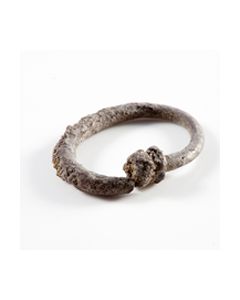 Ohrring aus Belutschistan, Indus-Kultur - Silber
Ohrring aus Belutschistan, Indus-Kultur - SilberSchlichter Ohrring, Verschluss als Hohlzylinder mit Einschnürung in der Mitte gestaltet. 15 mm x 17 mm, Gewicht 1.05 Gramm.
Price: on request Bronze Age chisel
Bronze Age chiselEtwa 2. Jt. v. Chr. bis Mitte 1. Jt. v. Chr., 2005 in Yorkshire, Großbritannien gefunden. Sehr gute Erhaltung.
Price: on request Altsyrisches Zylindersiegel
Altsyrisches ZylindersiegelVorderasiatisches Zylindersiegel mit Szene von Figuren und Tieren oder Fabelwesen in einem wellenförmigem Band. Um die Mitte des 2. Jt. v. Chr.
Price: on request Tafel mit assyrischem Gesetzestext in Keilschrift aus alter deutscher Sammlung
Tafel mit assyrischem Gesetzestext in Keilschrift aus alter deutscher SammlungFragment einer Tontafel mit altassyrischem Verwaltungs- oder Gesetzestext. Mitte bis Ende des 2. Jt. v. Chr.
Price: on request Bronze axe head from Luristan
Bronze axe head from LuristanVotivaxt oder eine Grabbeigabe mit symbolischer Funktion. Vermutlich aus Luristan. Mitte 3. - 2. Jt. v. Chr. Sehr guter Zustand, stabile Bronze mit kräftiger Patina.
Price: on request Baktrisches Alabastergefäß - einem Säulenidol ähnlich
Baktrisches Alabastergefäß - einem Säulenidol ähnlichMit ausgeprägter Standfläche, in der Mitte verjüngt, öffnet sich konisch nach oben. Spätes 3. Jt. - frühes 2. Jt. v. Chr.
Price: on request Scarab with geometric motive
Scarab with geometric motiveThe lower side exhibits a symmetrical arrangements of cords, two of which are wrapped around each other. This scarab is described in the catalogue of Irène Gautier-Vodoz.
Price: on request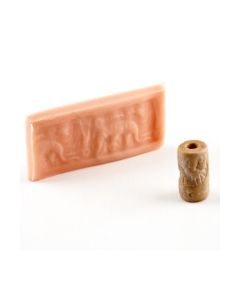 Cylinder seal from early dynastic Mesopotamia
Cylinder seal from early dynastic MesopotamiaDas frühdynastische Rollsiegel aus Mesopotamien zeigt eine Szene mit zwei Personen im Boot, eine davor stehende mit Stab. Es ist aus schönem karamellfarbenem Stein geschnitten. Mitte 3. Jt. v. Chr.
Price: on request Cowroid with magical anra formula
Cowroid with magical anra formulaThe bottom side hieroglyphs of the anra type are to be interpreted as magical formula. The amulet dates to the Second Intermediate Period of ancient Egpyt.
Price: on request Egyptian Scarab
Egyptian ScarabThe scarab amulet is made of steatite. It has a hieroglyphic inscription on the lower side.
Price: on request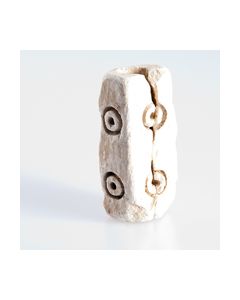 Verziertes baktrisches Alabastergefäß
Verziertes baktrisches AlabastergefäßInteressante, streng rechtwinklige Form, mit Ringbohrungen verziert. Massive Ausführung.
Price: on request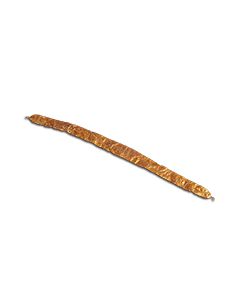 Mycenaean gold diadem
Mycenaean gold diademDelicate piece of ancient jewelry made of gold foil
Price: on request Silberohrring aus Belutschistan, Indus-Kultur
Silberohrring aus Belutschistan, Indus-KulturGroßer Ohrring aus Silber. Enden am Verschluss spiralförmig aufgewickelt, dadurch verziert. Massiv.
Price: on request Bronze age thorn pendant
Bronze age thorn pendantNicely preserved piece from a German collection.
Price: on request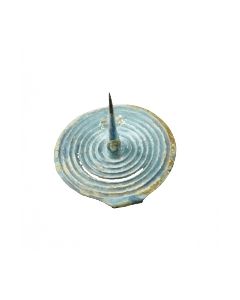 Bronze age thorn pendant
Bronze age thorn pendantNicely preserved piece from a German collection.
Price: on request Bronze age thorn pendant
Bronze age thorn pendantNicely preserved piece from a German collection.
Price: on request Bronze age thorn pendant
Bronze age thorn pendantNicely preserved piece from a German collection.
Price: on request Bronze age thorn pendant
Bronze age thorn pendantNicely preserved piece from a German collection.
Price: on request Bronze age thorn pendant
Bronze age thorn pendantNicely preserved piece from a German collection.
Price: on request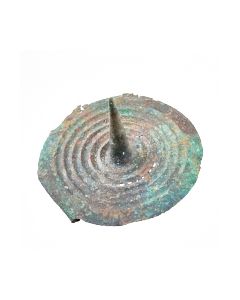 Bronze age thorn pendant
Bronze age thorn pendantNicely preserved piece from a German collection.
Price: on request Scarab with twisted cord
Scarab with twisted cordScarab amulet with a twisted cord motive. Beautiful and well preserved piece from the Second Intermediate Period.
Price: on request Ohrring aus Belutschistan, Indus-Kultur - Silber
Ohrring aus Belutschistan, Indus-Kultur - SilberSchlichte Formgebung. Spannendes, aus einem Edelmetall gefertigtes Belegstück aus der Frühzeit der Menschheitsgeschichte.
Price: on request Ohrring aus Belutschistan, Indus-Kultur - Silber
Ohrring aus Belutschistan, Indus-Kultur - SilberAufwendig gearbeiteter, massiver Ohrring. In Verschlussnähe Verzierung durch Spiralwindungen. Museales Stück, tolle, dunkle Patina.
Price: on request Ohrring aus Belutschistan, Indus-Kultur - Silber
Ohrring aus Belutschistan, Indus-Kultur - SilberAufwendig gearbeiteter, massiver Ohrring. In Verschlussnähe Verzierung durch Spiralen. Museales Stück, tolle, dunkle Patina.
Price: on request Ohrring aus Belutschistan, Indus-Kultur - Silber
Ohrring aus Belutschistan, Indus-Kultur - SilberVerschluss als zwei parallele Drähte gearbeitet, Verzierung durch Spiralwindungen. Gut erhaltenes Stück, dunkle Patina.
Price: on request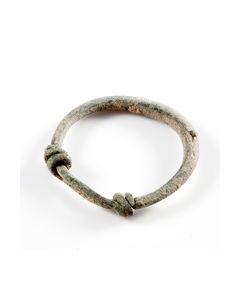 Ohrring aus Belutschistan, Indus-Kultur - Silber
Ohrring aus Belutschistan, Indus-Kultur - SilberVerschluss als zwei parallele Drähte gearbeitet, Verzierung durch Spiralwindungen. Gut erhaltenes Stück, dunkle Patina.
Price: on request Egyptian scarab with papyrus plants
Egyptian scarab with papyrus plantsScarab amulet made of bright, almost white steatite. 13th to 15th dynasty. This scarab is described in the catalogue of Irène Gautier-Vodoz.
Price: on request Scarab with scarab motive
Scarab with scarab motiveThe stamp side shows a scarab with two uraeus snakes. This scarab is described in the catalogue of Irène Gautier-Vodoz.
Price: on request Scaraboid with twisted cord
Scaraboid with twisted cordScaraboid seal amulet with a twisted cord motive. This scarab is described in the catalogue of Irène Gautier-Vodoz.
Price: on request Scaraboid with Red Crowns of Lower Egypt
Scaraboid with Red Crowns of Lower EgyptThe hieroglyphs on the lower side symbolize the rule over Lower Egypt. The rising sun is symbolized above. This scaraboid is described in the catalogue of Irène Gautier-Vodoz.
Price: on request Tonfigur eines Stiers aus Belutschistan
Tonfigur eines Stiers aus BelutschistanStilisierte Darstellung eines Stiers. 85 mm x 45 mm x 80 mm groß und fein gearbeitet. Dunkelroter Ton, 4. bis 2. Jt. v. Chr.
Price: on request Scarab from the Second Intermediate Period
Scarab from the Second Intermediate PeriodThe lower side shows a scarab, flanked by two uraeus snakes. 13th to 15th dynasty of ancient Egpyt. This scarab is described in the catalogue of Irène Gautier-Vodoz.
Price: on request Scarab with hieroglyphs arranged in a pattern
Scarab with hieroglyphs arranged in a patternThe lower side is skillfully decorated with hieroglyphs forming a geometric pattern. This scarab is described in the catalogue of Irène Gautier-Vodoz.
Price: on request Scarab with the Red Crown of Lower Egypt
Scarab with the Red Crown of Lower EgyptThe scene can be seen as worship of the Deshret, the symbol of the kings of Lower Egypt during Hyksos times. An interesting piece of evidence of the Hyksos rule over Egypt.
Price: on request Scarab with geometric motive
Scarab with geometric motiveThe lower side exhibits wrapped cords. A nice example of Egyptian art during the Second Intermediate Period. This scarab is described in the catalogue of Irène Gautier-Vodoz.
Price: on request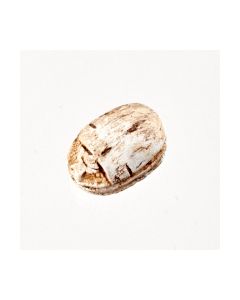 Scarab with lotus motive
Scarab with lotus motiveAncient Egyptian amulet seal with beautiful motive. Six lotus flowers are forming volutes. This scarab is described in the catalogue of Irène Gautier-Vodoz.
Price: on request

